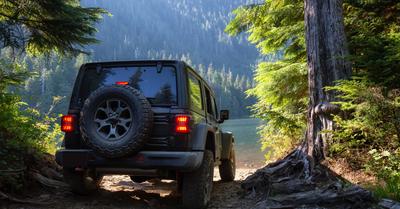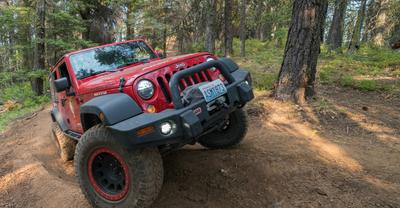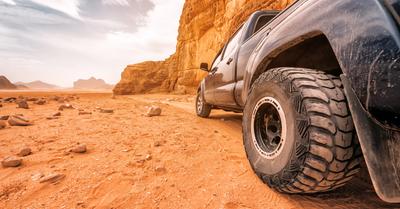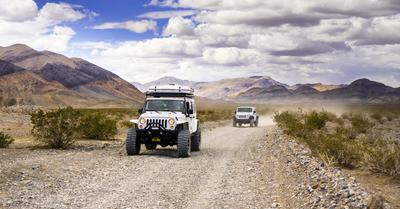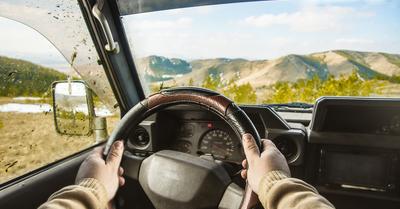Off-roading can certainly be a fun and challenging activity. But is it dangerous? And if so, how dangerous is off-roading?
Off-roading in a truck or SUV isn’t all that dangerous. The vast majority of off-road injuries are preventable ATV accidents, and trucks and SUVs are significantly safer. Plus, careful driving can prevent most off-roading incidents entirely.
In this article, we’ll discuss the potential dangers of off-roading in a truck or SUV and compare it to other popular motorsports. We’ll debunk three common misconceptions about the safety of off-roading and cover five ways to make your off-road trip safer and more manageable.
We sourced the information and statistics used in this article from verified sources, and we drew off the experience of the off-road community.
This article may contain affiliate links where we earn a commission from qualifying purchases.
Off-Roading Misconceptions
Off-roading has a reputation amongst some people for being an edgy and dangerous sport for thrill-seekers. These are usually the same people who haven’t ever been interested in trying it, let alone becoming an expert on the subject.
To set the record straight, here are three common myths about off-roading and its hazards, along with the reality behind them.
Myth: Off-Roading Hurts Lots of People
This is the most common (and most detrimental) myth about off-roading. The conversation goes something like this:
“Why would anyone want to drive up a mountain? That’s so dangerous. It should be illegal. Cars belong on the road and nowhere else.”
But is it actually dangerous? And is there any way to know for sure how dangerous off-roading really is?
Fact: Car and Truck Off-Roading is Safer than Other Motorsports
Actually, there is a way to find out how dangerous off-roading is—but it’s a bit complicated. And compared to other motorsports, off-roading in a truck or SUV is actually quite safe.
Chances are when people think of off-roading, they’re probably conflating two different types of off-road vehicles.
Off-road injuries and fatalities in trucks and SUVs are rare. So rare (comparatively) that nobody bothers keeping track of them. The vast majority of serious off-road accidents are on ATVs, where about 100,000 or so accidents with injuries occur annually.
With that in mind, it follows that driving in an actual car or truck is considerably safer. Seatbelts, side protection, and airbags are effective off-road as well, and drivers tend to operate a car or truck differently than a compact four-wheeler.
And as a quick reminder, a sizable portion of ATV injuries happen because the driver wasn’t wearing a helmet.
Myth: Off-Roading is Illegal
You’ve probably seen a local news story about kids getting busted for driving off-road illegally. There are plenty of trucks impounded for this reason, and it gives people the impression that off-roading is some sort of nefarious activity.
Fact: Off-Roading is Legal in Many Places
Off-roading is totally legal in many places—just not somebody else’s property without their permission. There are thousands of private and public off-road trails where it’s perfectly acceptable (and often encouraged) to drive.
Myth: Off-Roading Will Wreck Your Truck
Some people believe that using your truck or SUV off-road will void your warranty or destroy your suspension. Off-roading can certainly be hard on a vehicle, but how much damage is actually done?
Fact: Off-Roading Might Wreck Your Truck (But Probably Not)
It’s true that off-roading can ruin your suspension and steering and possibly total your truck. But so can driving it on the highway. Off-roading itself isn’t the reason why tie rods snap like toothpicks.
Your driving habits and skill level have a huge influence on the condition of your vehicle. While some damage is unavoidable, there are tens of thousands of people who off-road their daily driver regularly without wrecking anything permanently.
In other words, just take it easy, and you probably won’t break anything. And try not to high-center on big rocks. Just go around it!
Actual Risks of Off-Roading
Like anything that’s actually fun, off-roading comes with some inherent risks that can’t be done away with all the time. Driving on a remote dirt trail is probably more dangerous than driving on a suburban street, but it’s impossible to quantify exactly how much more dangerous it is.
One of the main risks of off-roading is rolling your vehicle. Rollovers happen a lot, and they’re particularly dangerous in older vehicles. Modern automakers have done a lot to reduce the risks to the occupants during a rollover, including installing roll bars and strengthening truck cabs.
Another potential risk is getting lost. Cell service is often spotty off-road, and you may lose your way if you don’t know the trail. However, pretty much everyone eventually finds their way back or encounters somebody along the way who knows the route.
Crashes are a risk of off-roading, and they’re more likely due to uneven terrain and potential tight corners. That said, off-readers travel at much slower speeds than residential and highway drivers, which makes injury less likely.
Other potential hazards such as rock slides, avalanches, and falling trees are also risks to hikers and campers, so there’s no reason to single out off-roading as a particularly dangerous activity.
How to Reduce Off-Roading Risks
Off-roading doesn’t have to be a dangerous activity. Careful driving, selecting manageable trails, and coming prepared can help you have a safe and fun time on the trail. Here are five things you can do to make off-roading safer.
1. Be Smart
Many off-road accidents can be avoided if the driver just acted responsibly. How many videos have you seen of truck jumping ending in disaster? Remember the Ford Raptor that could fly (but couldn’t land)?
People will do whatever they want at the end of the day, but you can do better and avoid reckless and thoughtless actions. In doing so, you’ll avoid most of the situations that lead to accidents, such as going too fast or trying to show off.
2. Bring Tools and Emergency Supplies
Tools can be the difference between a broken truck and a ride home. Bring a standard automotive tool set and some zip ties, at the very least. If you can, learn how your truck works and bring along the parts that are most likely to fail (and the tools you need to fix them).
Don’t run out of gas. Unless you’re on a massive excursion, running out of gas is the most preventable off-road problem. Also, bring a full first-aid kit in case somebody gets hurt. You never know who you’ll come across, and basic medical supplies might just save your life or someone else’s.
3. Bring a Buddy
Don’t go deep into the trail all alone, and certainly don’t venture off without telling someone where you are and when to expect you back. Off-roading is more fun with other people around, and there’s always an extra hand to help get you unstuck or render aid if you get hurt.
4. Maintain Your Vehicle
Keep your off-road vehicle in the best shape possible. Always make sure the brakes work, the tires aren’t leaking, and the engine runs properly. Bring an extra quart or two of oil, some coolant, and a can of fuel.
The most important thing is to make sure you can keep control of your vehicle. If the brakes fail, how are you going to do that? Maintenance is easier and cheaper than repairs.
5. Avoid Trails that are Too Challenging
Don’t stray too far beyond your experience level. Work your way up to the difficult trails so you’ll be confident in yourself and your vehicle. It takes time to build skills, and you don’t want to wreck your truck or get hurt for no reason. Just have fun and know what you’re getting into before you take off down the trail.


